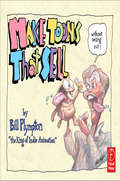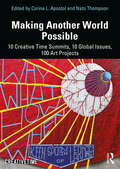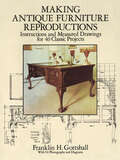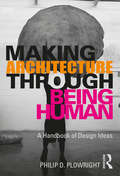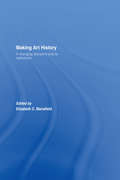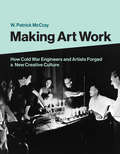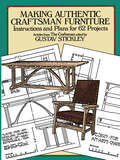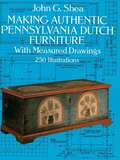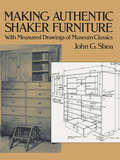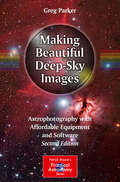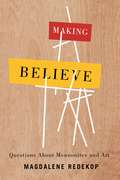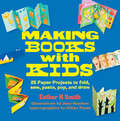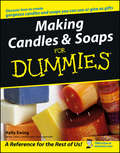- Table View
- List View
Makin' Toons: Inside the Most Popular Animated TV Shows and Movies
by Allan NeuwirthFrom the first drawing board sketch to wriggling TV character, Makin' Toons illustrates the thrills and challenges of making animated cartoon movies as told by the industry's most successful creators. Cartoon lovers everywhere will be treated to 47 personal interviews with animation artists and industry leaders ranging from Shrek director Andrew Adamson to Rugrats producer Gabor Csupo. These and dozens of other fascinating firsthand accounts chronicle the behind-the-scene antics and commercial dynamics behind such blockbusters as The Simpsons, South Park, Beauty and the Beast, and Dragon Tales, to name just a few. Author Allan Neuwirth-an accomplished animation artist and writer himself-spices the book with insightful comments, hilarious anecdotes, and a true "toon artist's" sense of humor. He also includes 75 never-before-published concept drawings, character designs, storyboards, and much more.Allworth Press, an imprint of Skyhorse Publishing, publishes a broad range of books on the visual and performing arts, with emphasis on the business of art. Our titles cover subjects such as graphic design, theater, branding, fine art, photography, interior design, writing, acting, film, how to start careers, business and legal forms, business practices, and more. While we don't aspire to publish a New York Times bestseller or a national bestseller, we are deeply committed to quality books that help creative professionals succeed and thrive. We often publish in areas overlooked by other publishers and welcome the author whose expertise can help our audience of readers.
Making 'Toons That Sell Without Selling Out: The Bill Plympton Guide to Independent Animation Success
by Bill PlymptonLearn the secrets behind independent animation from the "The King of Independent Animation" - Academy Award-nominated Bill Plympton. This living legend breaks down how to make a career outside of the world of corporate animation - and without compromise. Learn time-saving techniques, the secrets to good storytelling, and the business-side of short and feature-length animation films.
Making Ancient Cities
by Andrew T. Creekmore III Kevin D. FisherThis volume investigates how the structure and use of space developed and changed in cities, and examines the role of different societal groups in shaping urbanism. Culturally and chronologically diverse case studies provide a basis to examine recent theoretical and methodological shifts in the archaeology of ancient cities. The book's primary goal is to examine how ancient cities were made by the people who lived in them. The authors argue that there is a mutually constituting relationship between urban form and the actions and interactions of a plurality of individuals, groups, and institutions, each with their own motivations and identities. Space is therefore socially produced as these agents operate in multiple spheres.
Making Another World Possible: 10 Creative Time Summits, 10 Global Issues, 100 Art Projects
by Nato Thompson Corina L. ApostolMaking Another World Possible offers a broad look at an array of socially engaged cultural practices that have become increasingly visible in the past decade, across diverse fields such as visual art, performance, theater, activism, architecture, urban planning, pedagogy, and ecology. Part I of the book introduces the reader to the field of socially engaged art and cultural practice, spanning the past ten years of dynamism and development. Part II presents a visually striking summary of key events from 1945 to the present, offering an expansive view of socially engaged art throughout history, and Part III offers an overview of the current state of the field, elucidating some of the key issues facing practitioners and communities. Finally, Part IV identifies ten global issues and, in turn, documents 100 key artistic projects from around the world to illustrate the various critical, aesthetic and political modes in which artists, cultural workers, and communities are responding to these issues from their specific local contexts. This is a much needed and timely archive that broadens and deepens the conversation on socially engaged art and culture. It includes commissioned essays from noted critics, practitioners, and theorists in the field, as well as key examples that allow insights into methodologies, contextualize the conditions of sites, and broaden the range of what constitutes an engaged culture. Of interest to a wide range of readers, from practitioners and scholars of performance to curators and historians, Making Another World Possible offers both breadth and depth, spanning history and individual works, to offer a unique insight into the field of socially engaged art.
Making Antique Furniture Reproductions: Instructions and Measured Drawings for 40 Classic Projects
by Franklin H. GottshallWith this profusely illustrated guide, even beginning woodworkers can build precise reproductions of the most sought-after antique furniture -- heirloom pieces by Sheraton, Hepplewhite, Duncan, Phyfe, Chippendale, and other celebrated craftsmen. It's possible by following the simple, step-by-step procedures outlined in this expert manual.You'll learn how to construct such magnificent antiques as a Chippendale flat-topped partner's desk, Queen Anne handkerchief table, Sheraton drop-leaf dining table, Hepplewhite four-poster bed, grandfather clock, Queen Anne spice cabinet, and many more. Every step is clearly explained and illustrated, with remarkably detailed and precise construction drawings, accompanied by exact measurements. You'll even find superb photographs of the finished pieces.The book begins with an expert introduction to the fundamentals of cabinetmaking and woodworking: how to cut, square, and plane lumber; the use and care of hand tools; and then clear explanations of such processes as joinery, drawer construction, dovetailing, wood turning, gluing, bull and claw foot carving, and other wood carving details as well as how to choose the correct stock. Also included is a wealth of time-tested advice on selecting hardware, finishing, and other aspects of the craft.No matter what your level of woodworking expertise -- novice to expert -- the exceptionally precise and well-thought-out instructions and diagrams in this book will enable you to craft beautiful and authentic antique furniture you'll be proud to use and display for years to come.
Making Architecture Through Being Human: A Handbook of Design Ideas
by Philip D. PlowrightArchitecture can seem complicated, mysterious or even ill-defined, especially to a student being introduced to architectural ideas for the first time. One way to approach architecture is simply as the design of human environments. When we consider architecture in this way, there is a good place to start – ourselves. Our engagement in our environment has shaped the way we think which we, in turn, use to then shape that environment. It is from this foundation that we produce meaning, make sense of our surroundings, structure relationships and even frame more complex and abstract ideas. This is the start of architectural design. Making Architecture Through Being Human is a reference book that presents 51 concepts, notions, ideas and actions that are fundamental to human thinking and how we interpret the environment around us. The book focuses on the application of these ideas by architectural designers to produce meaningful spaces that make sense to people. Each idea is isolated for clarity in the manner of a dictionary with short and concise definitions, examples and illustrations. They are organized in five sections of increasing complexity or changing focus. While many of the entries might be familiar to the reader, they are presented here as instances of a larger system of human thinking rather than simply graphic or formal principles. The cognitive approach to these design ideas allows a designer to understand the greater context and application when aligned with their own purpose or intentions.
Making Art
by Ed BricklerA serious guide for the adventurous artist!Using the right tools and materials in the correct way can make a big difference in the success and enjoyment of your artistic process. This hands-on guide outlines the many options at your disposal, so that you can make the most of your art materials, your time in the studio, and your spirit of creative adventure.Bringing 25 years of expertise as an art materials consultant and workshop instructor, Ed Brickler covers everything from classic oil and watercolor techniques to contemporary uses of encaustics, acrylic gels, markers and more. His extensive knowledge and clear, step-by-step techniques will show artists of any level how to use various media to maximum potential.Explores 15 popular mediums--including graphite, pen & ink, oils, acrylics, watercolor, pastels, mixed media and more.Covers the various art materials and tools available on the market, offering expert advice on choosing the right supplies for a given medium.Takes the guesswork out of grounds, pigments, solvents and varnishes.Illustrates key techniques for each medium through 43 complete demonstrations and hundreds of close-up action photos. Based on the belief that a well-informed artist is a creative and productive artist, Marking Art will help you expand your repertoire of materials, approach your work with greater confidence, and give you the tools to express your artistic vision.
Making Art History in Europe After 1945 (Studies in Art Historiography)
by Noemi de Haro García Patricia Mayayo Jesús CarrilloThis book analyses the intermeshing of state power and art history in Europe since 1945 and up to the present from a critical, de-centered perspective. Devoting special attention to European peripheries and to under-researched transnational cultural political initiatives related to the arts implemented after the end of the Second World War, the contributors explore the ways in which this relationship crystallised in specific moments, places, discourses and practices. They make the historic hegemonic centres of the discipline converse with Europe’s Southern and Eastern peripheries, from Portugal to Estonia to Greece. By stressing the margins’ point of view this volume rethinks the ideological grounds on which art history and the European Union have been constructed as well as the role played by art and culture in the very concept of ‘Europe.’
Making Art History: A Changing Discipline and its Institutions
by Elizabeth C. MansfieldMaking Art History is a collection of essays by contemporary scholars on the practice and theory of art history as it responds to institutions as diverse as art galleries and museums, publishing houses and universities, school boards and professional organizations, political parties and multinational corporations. The text is split into four thematic sections, each of which begins with a short introduction from the editor, the sections include: Border Patrols, addresses the artistic canon and its relationship to the ongoing 'war on terror', globalization, and the rise of the Belgian nationalist party. The Subjects of Art History, questions whether 'art' and 'history' are really what the discipline seeks to understand. Instituting Art History, concerns art history and its relation to the university and raises questions about the mission, habits, ethics and limits of university today. Old Master, New Institutions, shows how art history and the museum respond to nationalism, corporate management models and the 'culture wars'.
Making Art Panamerican: Cultural Policy and the Cold War
by Claire F. FoxAmong the buildings on the National Mall in Washington, D.C., only the Pan American Union (PAU) houses an international organization. The first of many anticipated &“peace palaces&”constructed in the early twentieth century, the PAU began with a mission of cultural diplomacy, and after World War II its Visual Arts Section became a leader in the burgeoning hemispheric arts scene, proclaiming Latin America&’s entrée into the international community as it forged connections between a growing base of middle-class art consumers on one hand and concepts of supranational citizenship and political and economic liberalism on the other.Making Art Panamerican situates the ambitious visual arts programs of the PAU within the broader context of hemispheric cultural relations during the cold war. Focusing on the institutional interactions among aesthetic movements, cultural policy, and viewing publics, Claire F. Fox contends that in the postwar years, the PAU Visual Arts Section emerged as a major transfer point of hemispheric American modernist movements and played an important role in the consolidation of Latin American art as a continental object of study. As it traces the careers of individual cultural policymakers and artists who intersected with the PAU in the two postwar decades—such as Concha Romero James, Charles Seeger, José Gómez Sicre, José Luis Cuevas, and Rafael Squirru—the book also charts the trajectories and displacements of sectors of the U.S. and Latin American intellectual left during a tumultuous interval that spans the Mexican Revolution, the Spanish Civil War, the New Deal, and the early cold war. Challenging the U.S. bias of conventional narratives about Panamericanism and the postwar shift in critical values from realism to abstraction, Making Art Panamerican illuminates the institutional dynamics that helped shape aesthetic movements in the critical decades following World War II.
Making Art Work: How Cold War Engineers and Artists Forged a New Creative Culture
by W. Patrick MccrayThe creative collaborations of engineers, artists, scientists, and curators over the past fifty years.Artwork as opposed to experiment? Engineer versus artist? We often see two different cultural realms separated by impervious walls. But some fifty years ago, the borders between technology and art began to be breached. In this book, W. Patrick McCray shows how in this era, artists eagerly collaborated with engineers and scientists to explore new technologies and create visually and sonically compelling multimedia works. This art emerged from corporate laboratories, artists' studios, publishing houses, art galleries, and university campuses. Many of the biggest stars of the art world--Robert Rauschenberg, Yvonne Rainer, Andy Warhol, Carolee Schneemann, and John Cage--participated, but the technologists who contributed essential expertise and aesthetic input often went unrecognized.
Making Art a Practice
by Cat BennettHelping artists catapult into further action, this guide is a treasury of insight and inspiration. Rather than focus on art techniques that build skills or overcome creative blocks through playful activities or writing, this guide walks the artist through exercises designed to develop the personal qualities critical to being an artist in the world, such as courage, the ability to look and see, and connection to the true creative self. This is a hands-on, experiential action book designed to get the reader creating art and exploring a variety of possibilities for being an artist. According to the teachings of this handbook, engagement with art is less about end results or products and more about the self-awareness and competence that frees the artist to seek out and create work that is vital. This is a rigorous programme that allows artists of any skill level to deepen their creative habits and be the best artists possible.
Making Authentic Country Furniture: With Measured Drawings of Museum Classics
by John G. SheaThis outstanding work provides furniture makers and woodworkers with the principal antique country furniture designs used in North America during the past 400 years. Concerned only with provincial handmade designs — generally of simple solid-wood construction — John Shea's carefully researched and abundantly illustrated volume includes 95 measured drawings from which serious students and craftworkers can reproduce their own versions of these antique classics. All important European influences are represented — English, Irish, Scottish, Welsh, French, Dutch, German, Spanish, and Norwegian among them.Among the pieces represented are Shaker chairs, rockers, tables, and a wall cupboard; a New England settle, Spanish trestle table, Dutch gateleg table, French Canadian armoire and dresser, a Pennsylvania German corner cupboard and plate rack, as well as a wide array of country bedsteads, benches, stools, candlestands, plate racks, wall sconces, and much more.Additional sections of the book provide historical background to several regional designs, describing the effects that various nationalities and ethnic and religious roots have had on furniture design and construction. A number of construction techniques (for creating dovetail joints, applied moldings, scrolled paneling, cabriole legs, mortise-and-tenon joints, and more) are also explored.Profusely illustrated with some 800 photographs and line drawings, this richly informative manual will be valued by furniture makers for its clearly delineated technical segments as well as by anyone who has ever been fascinated by the construction and design of antique furniture.
Making Authentic Craftsman Furniture: Instructions and Plans for 62 Projects
by Gustav StickleyMake authentic reproductions of handsome, functional, durable furniture: tables, chairs, wall cabinets, desks, a hall tree, and more. Construction plans with drawings, schematics, dimensions, and lumber specs reprinted from 1900s The Craftsman magazine.
Making Authentic Pennsylvania Dutch Furniture: With Measured Drawings
by John G. SheaRichly illustrated guide to the design, construction, painting, and decoration of a host of distinctive pieces -- candle stands to four-posters. Includes designs for 24 popular hex signs and measured drawings for building 50 representative pieces: chairs, tables, desks, and many more. 250 illustrations. Bibliography.
Making Authentic Shaker Furniture: With Measured Drawings of Museum Classics
by John G. SheaThis splendid book describes and illustrates in detail how the Shakers designed, built, and finished their furniture and household articles. With its detailed text as well as over 250 photographs and measured drawings for over 80 classic pieces, it offers woodworkers and furniture enthusiasts a practical guide to the essentials of replicating a broad range of designs long admired for their sturdy practicality and their spare, elegant beauty.The book first chronicles and describes the Shaker movement and the Shaker way of living, worshiping, and working. It then explores the Shaker approach to furniture design (from chests and chairs to boxes and baskets), construction (including all joinery techniques), and finishing (including recipes for finishes).Three important sections of the book depict dozens of classic Shaker designs, complete with measured drawings. The designs include Shaker "smallcraft" such as a cutting board, scoop, candle sconce, peg-leg footstool and towel rack; more substantial "utility designs" such as a dough bin, cradle, dry sink, butcher block, and bonnet box; and furniture classics such as a Harvard trestle table, maple chair, lap desk, sewing chest, rocking chair, bed, settee and chest of drawers -- each in its own distinctive way defining the simple, practical grace of Shaker design.
Making Bags, A Field Guide: Supplies, Skills, Tips & Techniques to Sew Professional-Looking Bags; 5 Projects to Get You Started (A\field Guide Ser.)
by Jessica Sallie BarreraCouture bags without the couture price? Yes, please! A complete visual guide to bag-making from the founder of Sallie Tomato. Whether you&’re beginning or looking to expand your bag-making, you can create professional-looking bags to fit your style and practical needs with Making Bags. Bags are infinitely customizable projects—there are so many fabrics, hardware, and zippers to explore. This valuable resource has all the information and techniques needed to work with diverse materials and achieve endless style combinations. Trendy baguette bags, duffle bags, saddle bags, messenger bags, and many more styles are covered in this book. Make five bag projects to practice your new skills and apply basic to advanced sewing techniques—Jessica Barrera, the owner of Sallie Tomato, gives you the full scoop on fabrics from standard quilting cotton to specialty materials like cork, velvet, vinyl, kraft-tex (vegan leather), and so much more!
Making Baskets: Storey's Country Wisdom Bulletin A-96 (Storey Country Wisdom Bulletin Ser.)
by Maryanne GilloolySince 1973, Storey's Country Wisdom Bulletins have offered practical, hands-on instructions designed to help readers master dozens of country living skills quickly and easily. There are now more than 170 titles in this series, and their remarkable popularity reflects the common desire of country and city dwellers alike to cultivate personal independence in everyday life.
Making Beautiful Deep-Sky Images
by Greg ParkerThis book is based around the author's beautiful and sometimes awe-inspiring color images and mosaics of deep-sky objects. The book describes how similar "Hubble class" images can be created by amateur astronomers in their back garden using commercially available telescopes and CCD cameras. Subsequent processing and image enhancement in the "electronic darkroom" is covered in detail as well. A range of telescopes and equipment is considered, from the author's 11-inch with Hyperstar camera, down to more affordable instruments. Appendices provide links to free software - not available from a single source - and are themselves an invaluable resource.
Making Believe: Questions About Mennonites and Art
by Magdalene RedekopMaking Believe responds to a remarkable flowering of art by Mennonites in Canada. After the publication of his first novel in 1962, Rudy Wiebe was the only identifiable Mennonite literary writer in the country. Beginning in the 1970s, the numbers grew rapidly and now include writers Patrick Friesen, Sandra Birdsell, Di Brandt, Sarah Klassen, Armin Wiebe, David Bergen, Miriam Toews, Carrie Snyder, Casey Plett, and many more. A similar renaissance is evident in the visual arts (including artists Gathie Falk, Wanda Koop, and Aganetha Dyck) and in music (including composers Randolph Peters, Carol Ann Weaver, and Stephanie Martin). Confronted with an embarrassment of riches that resist survey, Magdalene Redekop opts for the use of case studies to raise questions about Mennonites and art. Part criticism, part memoir, Making Believe argues that there is no such thing as Mennonite art. At the same time, her close engagement with individual works of art paradoxically leads Redekop to identify a Mennonite sensibility at play in the space where artists from many cultures interact. Constant questioning and commitment to community are part of the Mennonite dissenting tradition. Although these values come up against the legacy of radical Anabaptist hostility to art, Redekop argues that the Early Modern roots of a contemporary crisis of representation are shared by all artists. Making Believe posits a Spielraum or play space in which all artists are dissembling tricksters, but differences in how we play are inflected by where we come from. The close readings in this book insist on respect for difference at the same time as they invite readers to find common ground while making believe across cultures.
Making Believe: Screen Performance and Special Effects in Popular Cinema
by Lisa BodeIn the past twenty years, we have seen the rise of digital effects cinema in which the human performer is entangled with animation, collaged with other performers, or inserted into perilous or fantastic situations and scenery. Making Believe sheds new light on these developments by historicizing screen performance within the context of visual and special effects cinema and technological change in Hollywood filmmaking, through the silent, early sound, and current digital eras. Making Believe incorporates North American film reviews and editorials, actor and crew interviews, trade and fan magazine commentary, actor training manuals, and film production publicity materials to discuss the shifts in screen acting practice and philosophy around transfiguring makeup, doubles, motion capture, and acting to absent places or characters. Along the way it considers how performers and visual and special effects crew work together, and struggle with the industry, critics, and each other to define the aesthetic value of their work, in an industrial system of technological reproduction. Bode opens our eyes to the performing illusions we love and the tensions we experience in wanting to believe in spite of our knowledge that it is all make believe in the end.
Making Better Buildings
by Chris Magwood Jen FeiginMuch has been written about the individual components of sustainable building, but how do you bring it all together into a well-designed whole? Drawing on extensive hands-on experience, Making Better Buildings systematically describes the real-world implications of the most popular green and natural building materials and techniques, objectively presenting the pros, cons and overall viability of each. An indispensable resource.
Making Birdhouses: Easy and Advanced Projects
by Leon H. Baxter Gladstone CaliffThis practical guide for building birdhouses contains plans for more than fifty attractive and useful structures — from a one-room house for bluebirds to a forty-two-room structure for purple martins. In addition to instructions and diagrams for constructing houses for such avian varieties as robins, wrens and chickadees, the easy-to-follow text also provides suggestions for feeding devices, bird house materials, methods of finishing exteriors, and winter care for birds. An authoritative, how-to book that will appeal to beginning and veteran woodcrafters alike, Making Birdhouses also features a supplement with easy projects for novices — among them simple structures for woodpeckers, a box for robins, and an “A-frame” for nuthatches. Plans for houses made from such common objects as gourds, a flower pot, tin cans, and an old lantern are also included.Detailed instructions and diagrams assure successful completion of projects that will satisfy builders as well as their feathered friends.
Making Books with Kids: 25 Paper Projects to Fold, Sew, Paste, Pop, and Draw (Hands-on Family Ser.)
by Esther K. SmithThis illustrated guide features twenty-five projects to share with crafty kids who love to read—with simple techniques for book binding, pop-up books and more!In Making Books with Kids, master book artist Esther K.¬†Smith shares kid-friendly, easy-to-follow instructions for a variety of fun and creative bookmaking projects—all supported with step-by-step, full-color photographs and illustrations. Each sequence is accompanied by finished samples and variations as well as Smith's own inspiring work.Full of paper crafting techniques, including sewing, collage, pop-up assemblage and more, the lessons in this book are both practical and open-ended, offering plenty of room for exploration and variation. Colorful photos illustrate how different people using the same lesson will yield different results, exemplifying the way the lesson brings out each artist's personal style. Children of all ages and experience levels can be guided by adults and will enjoy these engaging exercises.
Making Candles and Soaps For Dummies
by Kelly EwingMake floating candles, herbal soaps, and even a home spa Discover the secrets of color, shape, and scent the fun and easy way? Whether you're a beginner or seasoned craftperson, this fun book offers everything you need to make beautiful, professional-looking candles and soaps at home. You get practical tips on dyeing and scenting wax, using unusual molds, adding embellishments to candles, working with soap ingredients, and even turning your hobby into a business! Discover How To: Stock a safe & efficient work area Work with all types of wax Add color and scent to your projects Make melt-and-pour soaps Turn a hobby into a business

